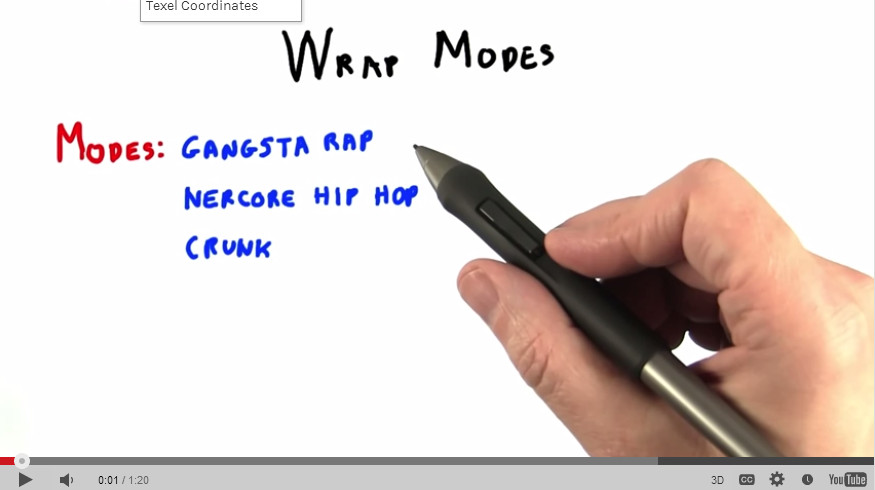Short version: the Interactive 3D Graphics course is now entirely out, the last five units have been added: Lights, Cameras, Texturing, Shader Programming, Animation. Massive (22K people registered so far), worldwide (around 128 countries, > 70% students from outside U.S.). Uses three.js atop WebGL. Start at any time, work at your own pace, only basic programming skills needed. Free.
That’s the elevator talk, Twitterized (well, maybe 3 tweets worth). I won’t blab on and on about it, just a few things.
First, it’s so cool to be able to show a student a video, then give a quiz, then let them interact with a demo, then have them write some code for an exercise, all in the browser. Udacity rocketh, both the web programmers and video editors.
Second, I’m very happy about how a whole bunch of lessons turned out. The tough part in all this is trying to not lose your audience. I think I push a bit hard at times, but some of my explanations I like a lot. Mipmapping, antialiasing, gamma correction – a number of the later lectures in particular felt quite good to me, and I thought things hung together well. Shhh, don’t tell me otherwise. Really, it’s not pride so much; I’m just happy to have figured out good ways to explain some things simply.
Third, I wrote a book, basically: it’s about 850 full-sized pages and about 145,000 words. It’s free to download, along with the videos and code. I think of this course as the precursor to Real-Time Rendering, sort of like “Star Wars: Episode 1”, except it’s good. I should really say “we wrote a book”: Gundega Dekena, Patrick Cozzi, Mauricio Vives, and near the end Branislav Ulicny (AlteredQualia) offered a huge amount of help in reviewing, catching various mistakes and suggesting numerous improvements. Many others kindly helped with video clips, interviews, permission to show demos, on and on it goes. Thanks all of you!
Fourth, I love that the demos from the course are online for anyone to point at and click on. Some of these demos are not absolutely fascinating, but each (once you know what you’re looking at) is handy in its own way for explaining some graphics phenomenon. The code’s all downloadable, so others can use them as a basis to make better ones. I’ve wanted this sort of thing for 16 years – took awhile to arrive, but now it’s finally here.
Fifth, working with students from around the world is wonderful! I love helping people on the forums with just a bit of effort on my end. Also, I just noticed a study group starting up. I’ve also enjoyed seeing contest entries, e.g., here are the drinking bird entries, click a pic to see it in WebGL:
What’s making a MOOC itself like? See John Owens’ excellent article – my experience is pretty much the same.
A close-up in the recording studio, my little world for a few weeks:










